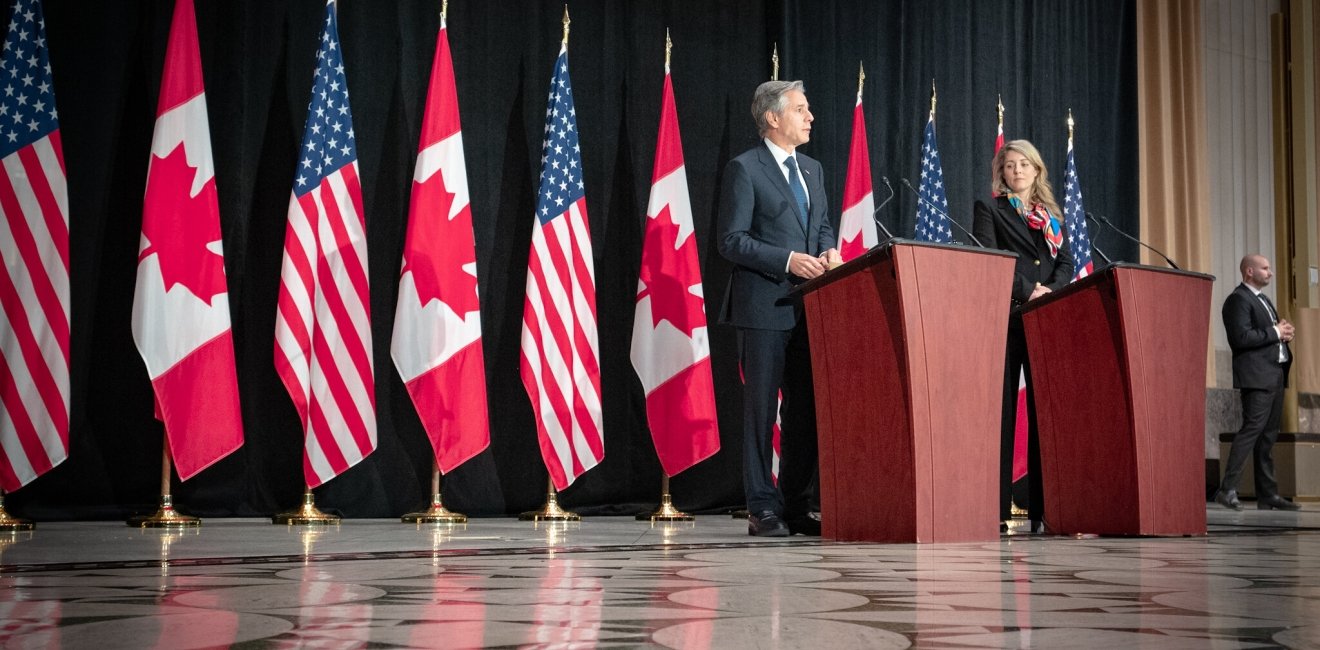U.S. Secretary of State Antony Blinken has just concluded a trip to Canada, where he met with government officials, business executives, and community leaders in Ottawa and Montreal. The Secretary’s visit, his first to Canada while serving in the Biden Administration, also held the distinction of being his first official state visit since the release of the latest U.S. National Security Strategy earlier this month.
The Goldwater-Nichols Department of Defense Reorganization Act of 1986 requires an annual National Security Strategy (NSS) to outline the White House’s security goals and assessment of threats to the nation. Typically, the first NSS issued by an administration is closely read for insights into the direction of U.S. leadership on the global stage: President Obama’s first NSS asserted that “[t]he burdens of a young century cannot fall on America’s shoulders alone” and President Trump’s warned of “[u]nfair burden sharing with [American] allies.”
The Biden Administration’s long-awaited NSS opens with an acknowledgement of the United States’ experience in “applying [its] power in combination with… allies and partners who significantly add to [its] own strengths.” This, the Administration argues, is the key to navigating a changing threat landscape that is defined by the end of the post-Cold War era and the emergence of cross-border challenges like pandemics, food insecurity, and climate change.
The new NSS invokes Canada’s name when discussing traditional areas of U.S.-Canadian collaboration: contributions to the Western Hemisphere, intelligence sharing through Five Eyes, and participation in multilateral institutions. These longstanding avenues for partnership are undeniably important, even as the global security nexus continues to evolve. Although the Biden Administration’s NSS pivots from the America-First tone of its predecessor by heralding cooperation with foreign allies as an essential tool for national security, Canadians may have expected more recognition for their ability to help in emerging fields of interest.
The underlying message of the NSS is that Washington expects more from its allies. Canadians should take note not only of where their country is mentioned in the document, but also where it isn’t: in the Indo-Pacific, critical minerals cooperation, and trade. The updated NSS indicates that if Canada desires a larger role in the United States’ security schemes, it must invest more in capabilities and resources that enhance the United States’ own strengths in novel areas of interest.
The NSS’ overview of the Indo-Pacific exemplifies the deficit between the United States’ perception of Canadian capabilities and Canada’s self-image as a middle power. Despite also being a Pacific nation, Canada has been largely excluded from the United States’ growing network of institutions in the region. The NSS mentions the Quadrilateral Security Dialogue and the AUKUS Security Pact, two U.S.-led defense institutions that will lead the charge in containing China’s influence and territorial ambitions. Canada was not a founding partner for either group – the latter of which was formed by three of its Five Eyes partners – nor was it initially included in the economically-oriented Indo-Pacific Economic Framework (IPEF), which encompasses 40 percent of global GDP.
Given the White House’s declaration in the NSS that “no region will be of more significance to the world and to everyday Americans than the Indo-Pacific,” Canada’s involvement in the theater, or lack thereof, will be consequential. Ottawa did manage to join the Partners in the Blue Pacific group, becoming the last of the Five Eyes countries to do so, and Minister Joly recently announced that Canada would seek membership in the IPEF during a joint press conference with Secretary Blinken. However, the Government has not yet delivered on its promise to release a national Indo-Pacific strategy, though it assembled an Indo-Pacific Advisory Committee over the summer to provide recommendations to the Minister. The lack of an Indo-Pacific strategy, and the delay in forming one, has left allies unsure about the extent of Canada’s commitment to the region.
This dynamic also plays out in the United States’ strategic objective to diminish reliance on China for critical minerals that feed into the supply chain of technologies like lithium-ion batteries and semiconductors. The NSS highlights the need to strengthen semiconductor supply chains, outlining the efforts made by the United States to improve research and development through the CHIPS and Science Act.
The opportunity for collaboration between the United States and Canada in this field was discussed in a recent meeting between U.S. Secretary of Commerce Gina Raimondo and Canadian Minister of Innovation, Science, and Industry, François-Philippe Champagne. Following the meeting, Secretary Raimondo and Minister Champagne reaffirmed their commitment to build supply chain resiliency on both sides of the border and increase collaboration in research and development as well as manufacturing capabilities.
Mexico is to host the next North American Leaders Summit, where it will welcome the leaders of both Canada and the United States for the first time since 2014. On North America, the NSS reads that “our priority is to work with Canada and Mexico to advance a North American vision for the future that draws on our shared strengths and bolsters U.S. global competitiveness.” However, this relatively brief mention of trilateral cooperation in the strategy does not shed much light on what the priorities of the NALS will be, nor does the NSS address the relationship between the three countries in any detail.
While the NSS recognizes the importance of strengthening international trading relationships and access to global markets for economic growth, the discussion of specific trade agreements is exclusionary when it comes to North America; there is no discussion of the United States-Mexico-Canada Agreement (USMCA) in the National Security Strategy. The reference to a “North American vision” is in fact the only mention of Mexico (and one of only a few mentions of Canada) by name in the strategy, despite an earlier mention in the NSS addressing the importance of facing shared challenges across borders. Climate change, food insecurity and inflation are just a few of the key issues raised by the NSS that may not traditionally be viewed as security threats, but are in fact crucial and require a coordinated response within North America and beyond.
Canadians can nevertheless be optimistic about the areas in which the Biden Administration’s NSS recognizes Canada’s importance. Most notably, the document mentions the “Canadian-launched Declaration Against Arbitrary Detention in State-to-State Relations,” a particularly poignant issue for Canada after China’s three-year detention of Canadian nationals Michael Spavor and Michael Kovrig. As of its first anniversary in February 2022, the Declaration had 68 endorsements from likeminded states representing each continent; its acknowledgement in the NSS is an important nod towards Canada’s strength in setting international norms that are in line with U.S. values. Global forums like the G7 and OECD, both of which Canada is a member of, are also spotlighted in the NSS for their ability to set international standards for everything from taxation to cybersecurity.
Canada is also highlighted as a leader in the Western Hemisphere. The NSS notes that the Administration’s priority is “to work with Canada and Mexico to advance a North American vision for the future that draws on our shared strengths.” With the longest shared land border in the world separating the two nations, Canada will be a vital partner in protecting Americans and the continent at large from a growing roster of cross-border threats that includes diseases and extremist ideology.
The new National Security Strategy provides insight into how Canada is perceived by the United States as a partner in regional and global security issues. Although Canada is not frequently referenced in the NSS, the importance of the bilateral relationship as a foundation for security partnerships between Canada and the United States was underscored by Secretary Blinken’s recent visit.
In the pursuit of its security objectives, the Biden Administration recognizes that “[America] can do none of this alone and [it does] not have to.” The NSS is not exclusionary; rather, it explores areas of concern where the United States can benefit from partnerships with likeminded states. Canada is well-positioned to be a partner of choice, but so are friendly competitors like Australia, New Zealand, and the United Kingdom. Ottawa cannot expect to be included in the United States’ security plans solely based on its close ties to Washington.
Both countries stand to benefit from a larger Canadian role in the United States’ vision for national security. Canada continues to have a unique opportunity to align itself with its closest ally on the international stage to strengthen security, both at home and abroad. To ensure this opportunity is not missed, Canada must demonstrate its resolve as a partner through investment and political action in ways that augment U.S. strength.







